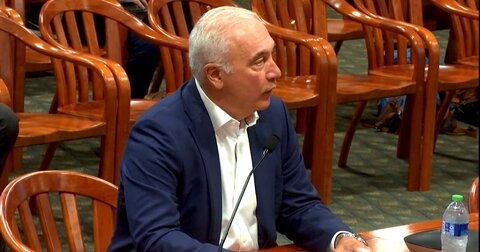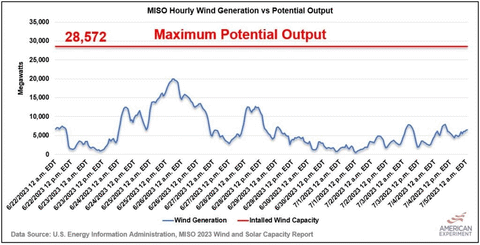Commentary
‘Can’t count on it’: DTE boss says the quiet part out loud on wind and solar
Hayes: Relying on wind and solar would leave Michigan in the lurch

DTE CEO Jerry Norcia said the quiet part out loud on the unreliable nature of wind and solar, Jason Hayes argues. (Screenshot: Michigan House TV)
Isaac Orr at the Center of the American Experiment describes wind energy’s continued failures in a recent blog post, demonstrating, once again, why its supporters are forced to refer to it as “reliably unreliable.”
“When electricity demand was highest, wind produced only 5.9 percent of its potential output, compared to its capacity value of 18.1 percent,” says Orr. “This means MISO expected wind turbines to produce 5,171 MW of electricity during this time, but they only produced 1,686 MW.”
Orr goes on to explain that our unreasonably optimistic habit of overestimating the capacity of renewable sources to produce electricity is becoming a problem. That’s because utilities, elected officials and government agencies in Midwestern states refuse to let go of, or even pause, their plans to move away from reliable fossil and nuclear energy to unreliable wind and solar. But if the wind doesn’t blow and the sun doesn’t shine, we face the real possibility that our electricity supplies could be restricted, or that our lights might go out.
Orr’s post was made all the more interesting because his information highlights recent testimony given by DTE CEO Jerry Norcia to the Michigan House Energy Committee.
“The first thing that we worry about is reliability,” explained Norcia. “We don't want to destabilize the grid, right? We’ve seen it happen in other jurisdictions, you know, we've seen it happen in California and other states. We've seen it happen there in a fundamental way. And so, we pay very careful attention that as we retire coal plants, we're replacing it with assets that can be called on when you need them.”
Norcia is walking a fine line by acknowledging the obvious need for reliable or dispatchable energy assets, while still going along with the alleged consensus that we must immediately transition our energy systems to wind and solar. But the push to change our energy systems is making the electrical grid increasingly fragile and unreliable, and Norcia clearly recognizes the problem.

The Mackinac Center has made this same point many times.
So, whether or not Norcia wants the company, he is not alone. It’s refreshing to see a utility executive so bluntly stating the need for reliable supplies of electricity.
While he couches his statement carefully, Norcia continues, almost appearing to quote the Mackinac Center: “So, for example, natural gas assets are there when you need them. Nuclear assets are there when you need them.”
Norcia’s next statement drives home the reliable-or-green dichotomy described above.
“Now, solar and wind are fabulous resources, but sometimes you can't count on it when you need it,” Norcia said.
That’s saying the quiet part out loud, and adding “sometimes” does little to reduce the sting of this public admission, from the CEO of one of Michigan’s largest utilities. As utilities implement plans to spend billions building more and more of wind and solar resources, utilities have to admit (for the record in an Energy Committee hearing) that, “you can’t count” on them.
This admission isn’t anything new. In a world where physics still works, we all know that the wind does not blow 24/7/365 and the sun does not shine 24/7/365. And, when wind and solar go to zero (or near-zero as our experience and Orr’s post above shows is common), you need reliable energy sources to fill that yawning and increasingly dangerous gap. In today’s world, that means nuclear and fossil fuels.
“So,” Norcia continued in his comments, “we need to have this portfolio approach where we need to have natural gas, we need to have battery systems we need to have renewables. And we need to have nuclear and I think if we continue on that path as a state, then we can assure ourselves that we're going to have a reliable grid and also the fundamental carbon reductions.”
Of course, he’s right about gas and nuclear. They do provide the reliable and affordable energy we all need. But it’s not surprising that he refers to wind and solar as “fabulous,” as monopoly utilities are profit-seeking businesses that are protected from competitive pressures by the state government.
Utility executives are acutely aware that the state’s Public Service Commission has routinely approved their requests for rate increases. It also has ensured they receive a 10% returns on equity, where the state guarantees utility profits of $0.10 on every dollar they spend building new wind and solar.
Additionally, utility executives know that the taxpayer is on the hook for tens of billions in federal handouts in favorable tax credits for wind and solar: the production tax credit and the intermittent tax credit. The executives also know that with their state government-approved peak rate programs, utilities are able to impose California-level electricity rates on their customers to cover the rapidly growing costs of using wind and solar.
Norcia’s statement admits a serious flaw in utilities’ plans to provide the people of Michigan with reliable electric services. “You can't count on [wind and solar] when you need [them],” speaks volumes. Utility planners who rely on things they admit can’t be counted on when they are needed for over 60% of the company’s generation mix are neither reasonable nor prudent. It’s well past time for utilities to restart their planning processes.
Jason Hayes is the Mackinac Center’s director of energy and environmental policy. Email him at hayes@mackinac.org.
|

‘Can’t count on it’: DTE boss says the quiet part out loud on wind and solar
Hayes: Relying on wind and solar would leave Michigan in the lurch
Isaac Orr at the Center of the American Experiment describes wind energy’s continued failures in a recent blog post, demonstrating, once again, why its supporters are forced to refer to it as “reliably unreliable.”
“When electricity demand was highest, wind produced only 5.9 percent of its potential output, compared to its capacity value of 18.1 percent,” says Orr. “This means MISO expected wind turbines to produce 5,171 MW of electricity during this time, but they only produced 1,686 MW.”
Orr goes on to explain that our unreasonably optimistic habit of overestimating the capacity of renewable sources to produce electricity is becoming a problem. That’s because utilities, elected officials and government agencies in Midwestern states refuse to let go of, or even pause, their plans to move away from reliable fossil and nuclear energy to unreliable wind and solar. But if the wind doesn’t blow and the sun doesn’t shine, we face the real possibility that our electricity supplies could be restricted, or that our lights might go out.
Orr’s post was made all the more interesting because his information highlights recent testimony given by DTE CEO Jerry Norcia to the Michigan House Energy Committee.
“The first thing that we worry about is reliability,” explained Norcia. “We don't want to destabilize the grid, right? We’ve seen it happen in other jurisdictions, you know, we've seen it happen in California and other states. We've seen it happen there in a fundamental way. And so, we pay very careful attention that as we retire coal plants, we're replacing it with assets that can be called on when you need them.”
Norcia is walking a fine line by acknowledging the obvious need for reliable or dispatchable energy assets, while still going along with the alleged consensus that we must immediately transition our energy systems to wind and solar. But the push to change our energy systems is making the electrical grid increasingly fragile and unreliable, and Norcia clearly recognizes the problem.
The Mackinac Center has made this same point many times.
So, whether or not Norcia wants the company, he is not alone. It’s refreshing to see a utility executive so bluntly stating the need for reliable supplies of electricity.
While he couches his statement carefully, Norcia continues, almost appearing to quote the Mackinac Center: “So, for example, natural gas assets are there when you need them. Nuclear assets are there when you need them.”
Norcia’s next statement drives home the reliable-or-green dichotomy described above.
“Now, solar and wind are fabulous resources, but sometimes you can't count on it when you need it,” Norcia said.
That’s saying the quiet part out loud, and adding “sometimes” does little to reduce the sting of this public admission, from the CEO of one of Michigan’s largest utilities. As utilities implement plans to spend billions building more and more of wind and solar resources, utilities have to admit (for the record in an Energy Committee hearing) that, “you can’t count” on them.
This admission isn’t anything new. In a world where physics still works, we all know that the wind does not blow 24/7/365 and the sun does not shine 24/7/365. And, when wind and solar go to zero (or near-zero as our experience and Orr’s post above shows is common), you need reliable energy sources to fill that yawning and increasingly dangerous gap. In today’s world, that means nuclear and fossil fuels.
“So,” Norcia continued in his comments, “we need to have this portfolio approach where we need to have natural gas, we need to have battery systems we need to have renewables. And we need to have nuclear and I think if we continue on that path as a state, then we can assure ourselves that we're going to have a reliable grid and also the fundamental carbon reductions.”
Of course, he’s right about gas and nuclear. They do provide the reliable and affordable energy we all need. But it’s not surprising that he refers to wind and solar as “fabulous,” as monopoly utilities are profit-seeking businesses that are protected from competitive pressures by the state government.
Utility executives are acutely aware that the state’s Public Service Commission has routinely approved their requests for rate increases. It also has ensured they receive a 10% returns on equity, where the state guarantees utility profits of $0.10 on every dollar they spend building new wind and solar.
Additionally, utility executives know that the taxpayer is on the hook for tens of billions in federal handouts in favorable tax credits for wind and solar: the production tax credit and the intermittent tax credit. The executives also know that with their state government-approved peak rate programs, utilities are able to impose California-level electricity rates on their customers to cover the rapidly growing costs of using wind and solar.
Norcia’s statement admits a serious flaw in utilities’ plans to provide the people of Michigan with reliable electric services. “You can't count on [wind and solar] when you need [them],” speaks volumes. Utility planners who rely on things they admit can’t be counted on when they are needed for over 60% of the company’s generation mix are neither reasonable nor prudent. It’s well past time for utilities to restart their planning processes.
Jason Hayes is the Mackinac Center’s director of energy and environmental policy. Email him at hayes@mackinac.org.
Michigan Capitol Confidential is the news source produced by the Mackinac Center for Public Policy. Michigan Capitol Confidential reports with a free-market news perspective.